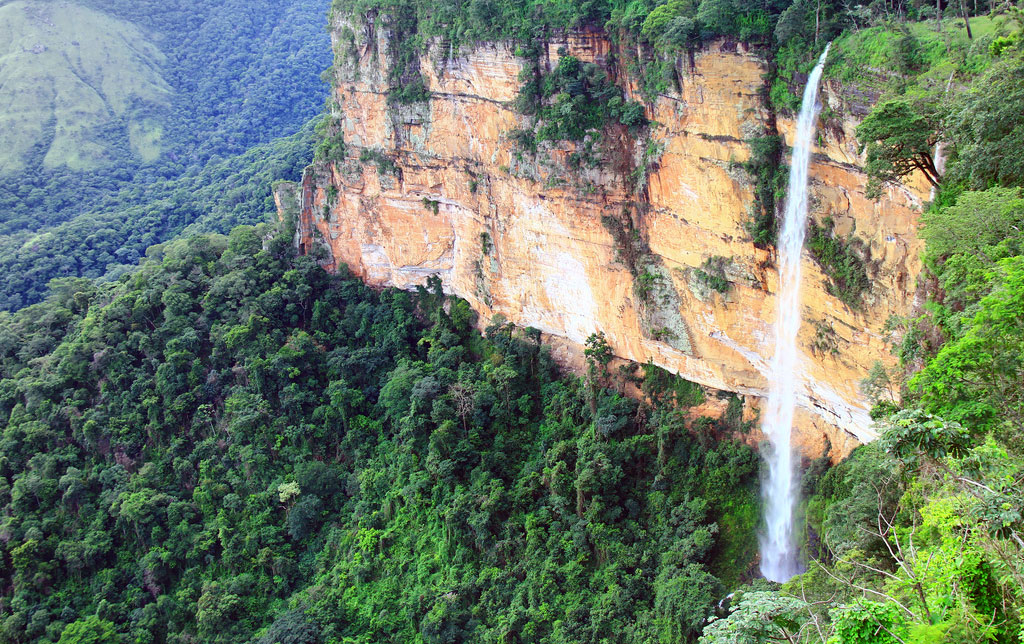
The “Bride’s Veil” waterfall in Chapada dos Guimarães. Photo © Cecilia Heinan, licensed Creative Commons Attribution.
Only an hour from Cuiabá, the Chapada dos Guimarães is a stunningly beautiful mountainous region situated on one of the planet’s oldest tectonic plates. While the tiny eponymous town is pretty—and the nexus for Brazilian New Age types—the surrounding region, with its rugged cliffs, plunging canyons, and abundant waterfalls, is the real draw. Arid scrubland and coppery red rock formations reminiscent of the Grand Canyon alternate with lush patches of tropical foliage that sprout around the many rivers and natural pools. Much of the area is preserved within the Parque Nacional da Chapada dos Guimarães, a park with breathtakingly scenic (though often unmarked) hiking trails and numerous waterfalls that you can swim in. Take note that in the winter months (July–August), temperatures can go down to freezing at night. Summer months are better for bathing and for taking advantage of the marvelous vistas (in the winter, mist is common), but there are also more crowds and frequent rains.Coming from Cuiabá, the entrance to the Parque Nacional da Chapada dos Guimarães (tel. 65/3301-1133, 8 a.m.–5 p.m. daily) is on MT-251 about 15 kilometers (9 miles) before the town of Chapada dos Guimarães. The park’s visitors center is about 8 kilometers (5 miles) past the park entrance and is equipped with a restaurant, a snack bar, a store selling artesanato, and maps of the park. From here, it’s only a five-minute walk to a lookout point where you’ll come face-to-face with the park’s star attraction: the Cachoeira Véu da Noiva, the 86-meter (282-foot) “Bride’s Veil” waterfall that goes plunging straight over a sandstone cliff into a pool (access to the bottom of the falls, where it’s possible to bathe, is indefinitely closed). Other popular trails (which require the accompaniment of a hired guide) include the Circuito das Cachoeiras, a six-hour hike that passes seven waterfalls (with stops for swimming), and the strenuous eight-hour trek that leads to the Morro de São Jerónimo (closed Tues.–Wed.), the highest point of the region, from whose summit the views are astounding.
Beyond the park’s boundaries are some other worthy attractions. The Caverna Aroe Jari is an enormous 1,400-meter-long (4,593-footlong) sandstone cavern 40 kilometers (25 miles) northeast of town (getting there involves driving along a dirt road and then hiking 8 kilometers/5 miles—a guided tour is essential) whose walls are decorated with primitive paintings dating back 8,000 years. An adjacent cave shelters the Lagoa Azul, whose crystalline waters turn brilliant blue when hit by the midday rays of the sun. Both sights are located on private land for which there is an entrance fee (R$15). Open daily, visitors must enter before 1 p.m. Easier to visit is the Mirante da Geodésia, 8 kilometers (5 miles) from town on an extension of the Rua Cipriano Curvo, which marks the geodesic center of the South American continent (the equidistant point between the Atlantic and Pacific oceans). The mirante (lookout) itself is at the edge of a canyon and offers spectacular sweeping views that include the distant towers of Cuiabá.
The Chapada’s geodesic centrality and the positive energies associated with this fact are partially responsible for a certain mystical, neo-hippie aura that permeates the charming little town of Chapada dos Guimarães. The pretty main square, Praça Dom Wunibaldo, conserves the baroque Igreja de Nossa Senhora de Santana do Sacramento, Mato Grosso’s oldest church, dating to 1779. If you visit in late June–early July, take advantage of the Festival de Inverno, a lively arts and music festival with an interesting alternative edge. The town is also a good place to pick up locally produced art and handicrafts. Several good shops are located on Praça Dom Wunibaldo; one of the most interesting and least touristy is ipiaío (tel. 65/9214-8420, 10 a.m.–7 p.m. Mon.–Sat.), featuring original and clever pieces such as embroidered saints’ altars made from sardine tins made by owner and local artist Vany Pinheiro.
The tourist office (Av. Perimetral 210, tel. 65/3301-3214, 9 a.m.–6 p.m. Mon.–Sat.) has maps of the park and Chapada along with a list of guides. You can also visit www.chapadadosguimaraes.tur.br and www.chapadadosguimaraes.com.br, both informative sites (in Portuguese) with lots of photos. The latter has some shaky English translations and is operated by Ecoturismo Cultural (Praça Dom Wunibaldo 464, tel. 65/3301-1393), a friendly and helpful tour operator that organizes guided day trips as well as longer itineraries. The classic Circuito das Cachoeiras excursion, for example, costs R$120 for up to four people.
Chapada dos Guimarães is 74 kilometers (46 miles) north of Cuiabá. Expresso Rubi (tel. 65/3621-2188) buses leave several times a day from the Rodoviária. The scenic trip takes about one hour and costs R$10. By car, follow MT-251.
Excerpted from the Third Edition of Moon Brazil.